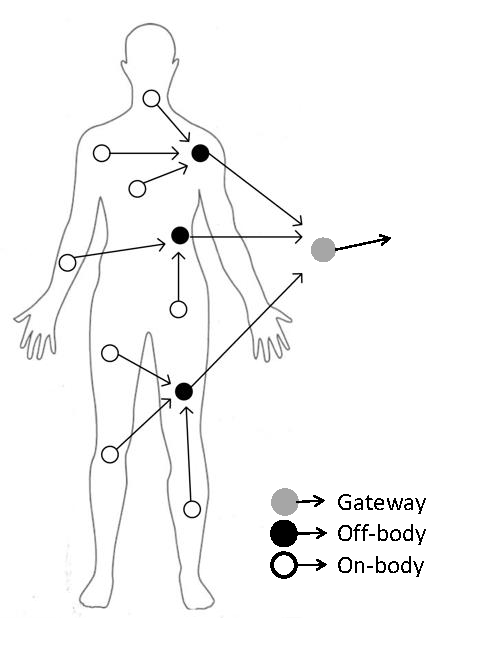Wireless Body Area Networks (WBANs)
A Wireless Body Area Network (WBAN) connects independent nodes or sensors that are on the body of a person. The network typically expands over the whole human body and is sometimes expanded using nodes that are located inside the body. The nodes that make up the WBAN are either interconnected through a wireless communication channel, or, alternatively, are connected to a central processing unit that may be located on or off the body. The most frequently listed applications of WBANs are the monitoring of vital parameters and communication between smart textiles.
An important step in the development of a WBAN is the characterization of the physical layer of the network, including an estimation of the delay spread and the path loss between two nodes on the body. This requires a detailed characterization of the electromagnetic wave propagation and antenna behavior near the human body.

(Figure adapted from Rahman et al., 2011, Sensors 11 (12))
In this area of research, the waves group has acquired several competences:
- Path loss characterization between on-body antennas using either radio-frequency (RF) measurements or numerical simulations using techniques such as the finite-difference time-domain (FDTD) algorithm or the method of moments (MoM).
- Characterization of path loss, antenna characteristics, and absorption of electromagnetic radiation inside the body using the same numerical techniques and using RF measurements inside a standardized phantom filled with tissue-simulating liquid.
- On-body antenna characterization of WBANs used for off-body communication or receiving purposes, using measurements in an anechoic, reverberation, and real environment.
- Determination and optimization of on-body positions of the nodes that make up a WBAN using the aforementioned techniques.
- Radio-frequency exposure assessment using a personal, distributed exposimeter (PDE).
- Characterization of 5th generation WBANs operating at 60 GHz both numerically and using antenna measurements.
- Improving indoor personal localization using distributed nodes.
- WBAN modelling for animals
- iMinds-MoniCow.
- Accedera: ANSES funded, in collaboration with Unibas/Swiss TPH, Utrecht University, INERIS, and CREAL.
- University of Lille 1, France
- University of Rennes, France
- VITO, Flanders
- University of Basel (Unibas) / The Swiss Tropical Health Institute (TPH), Switzerland
- Utrecht University, The Netherlands
- INERIS, France
- Centre for Research in Environmental Epidemiology (CREAL), Spain
- Monash University, Australia
- Application of the PDE in the ACCEDRA project, where personal RF exposure is compared in five European Countries.
- Development of a WBAN for health monitoring of farm animals.
